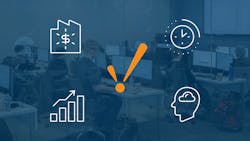The learning curve for implementing new SCADA software can be steep, and the right training tools can be critical for a team to hit the ground running. As a team prepares to learn new software, avoiding these four training misconceptions will help set them up for success.
Misconception 1: Training is too expensive and time-intensive.
Effective training requires dedicated staff time and resources. As a result, some organizations forego training and ask staff to figure things out on their own. According to Kent Melville, sales engineering manager at Inductive Automation, this strategy is flawed.
“The greatest cost associated with a well-trained team is the opportunity cost,” Melville says. When companies skip training, he says, they risk making mistakes, producing lower-quality work and weakening their ability to prevent issues in the future.
When organizations make an investment in training, however, “the solutions put into place tend to be higher quality because they are not thrown together,” Melville says. “They’ve had some time to think about what a good system looks like, and so they’re able to put it in right the first time.”
While traditional training solutions often required traveling to expensive off-site classes, online options are now more readily available. Inductive Automation created Inductive University for their Ignition software platform, devoting more than 10,000 man hours to developing free, online resources available to anyone.
Misconception 2: The best way to learn new software is by attending a one-time intensive class.
This is a common practice. To help limit costs, teams will often send one team member to an in-person training class. Upon their return, this team member then must train the rest of the team. Since intensive training classes do not allow people to learn in their own environment, however, this practice may not be as effective or long-lasting.
“People find that when they go, they have this positive experience because it’s a very carefully cultivated environment for them to learn,” Melville says. “When they come back to the real world, they find that everything isn’t exactly like they saw in the class.”
After a training session, relevant course materials may no longer be accessible to participants, or may be buried in a large user manual. If a team member struggles to translate their training to their work environment or to access information quickly, it can make it more difficult for them to train others. Providing all staff with direct access to training resources will ensure everyone receives the most accurate information from a first-hand source and empowers them to drive their own learning.
Dedicating time to train staff is necessary to conquering the software learning curve, but it pays dividends, Melville says. When onboarding teams to Ignition, Melville recommends staff devote a week to learn the platform piece by piece. They then have access to short, digestible videos that are easily searchable to review material or help with specific issues as they arise.
Misconception 3: Everyone learns best by sitting through a presentation.
Different people have different learning styles. While some team members prefer written documentation and online user manuals, others prefer watching demonstrations, or even performing the task themselves. Effective training must be designed to be effective for all types of learners.
To help first-time Ignition users learn by doing, Inductive Automation launched the Quick Start feature in November 2020. Quick Start launches Ignition with built-in templates and configurations so that “out of the gate, Ignition is in a useful state,” Melville says.
The Quick Start feature has been so popular that long-time users wanted a way to download the feature themselves to copy templates. As a result, all users of Ignition can now use Quick Start.
Misconception 4: One training session is all you need to learn new software.
Software is constantly updating. As a result, a training session a staff member attended years or even months ago can never fully prepare them for new features or current capabilities. Regular training on the latest functionality is necessary to keep skills current and prevent a team from implementing outdated processes.
“It’s one thing to train new staff, but it’s the next level to constantly train all of your staff,” Melville says. “When your staff is better trained, then they’re able to make sure your product or system stays relevant and you’re following best practices. They’re going to set up the business to succeed long-term rather than just being focused on maintaining the status quo.”

